Eurasian and northern watermilfoil hybrid
(Myriophyllum spicatum x sibiricum)
This species is Introduced in the United States
Hybrid watermilfoils have intermediate characteristics, including a variable number of leaflets, usually in a range of overlap between the parent species, and some genetic strains may form turions (underwater buds), while others will not.
Appearance
Stems terete (round in cross-section), hairless, pale greenish-tan to red in color, up to 6 meters long (though length is not confirmed for hybrid). Stems may branch anywhere along the length (Eurasian stems often highly branched at or near the water surface and Northern watermilfoil stems branch lower in the water column and not as profusely as Eurasian watermilfoil).
Foliage
Two types of leaves, feather-like submersed leaves having 16 -28 leaflets and being 16 to 44 mm long, and very small leaf-like bracts on the flower stem that typically rise above the water surface.
Flowers
Many flowers are borne on an unbranched stalk to 15 cm (6 in) long, usually rising above the water surface. Female flowers are at the bottom, and male flowers are at the top, with bisexual flowers in between. Usually in whorls of 4, flowers have 4 sepals and petals that are small, cream to purplish, often deciduous. Stamens 8. Pistils with 4 styles. Flowers are wind pollinated.
Appearance
Stems terete (round in cross-section), hairless, pale greenish-tan to red in color, up to 6 meters long (though length is not confirmed for hybrid). Stems may branch anywhere along the length (Eurasian stems often highly branched at or near the water surface and Northern watermilfoil stems branch lower in the water column and not as profusely as Eurasian watermilfoil).
Foliage
Two types of leaves, feather-like submersed leaves having 16 -28 leaflets and being 16 to 44 mm long, and very small leaf-like bracts on the flower stem that typically rise above the water surface.
Flowers
Many flowers are borne on an unbranched stalk to 15 cm (6 in) long, usually rising above the water surface. Female flowers are at the bottom, and male flowers are at the top, with bisexual flowers in between. Usually in whorls of 4, flowers have 4 sepals and petals that are small, cream to purplish, often deciduous. Stamens 8. Pistils with 4 styles. Flowers are wind pollinated.
Maps
EDDMapS Distribution - This map is incomplete and is based only on current site and county level reports made by experts, herbaria, and literature. For more information, visit www.eddmaps.org
State Lists - This map identifies those states that have this species on their invasive species list or law.
Invasive Listing Sources
Taxonomic Rank
| Domain: Eukarya |
| Kingdom: Plantae |
| Phylum: Magnoliophyta |
| Class: Magnoliopsida |
| Superorder: Saxifraganae |
| Order: Saxifragales |
| Family: Haloragaceae |
| Genus: Myriophyllum |
| Myriophyllum spicatum x sibiricum |
References
Common Name Reference: USDA, ARS, National Genetic Resources Program. Germplasm Resources Information Network - (GRIN) [Online Database]. National Germplasm Resources Laboratory, Beltsville, Maryland. URL: http://www.ars-grin.gov/cgi-bin/npgs/html/queries.pl
Scientific Name Reference: USDA, ARS, National Genetic Resources Program. Germplasm Resources Information Network - (GRIN) [Online Database]. National Germplasm Resources Laboratory, Beltsville, Maryland. URL: http://www.ars-grin.gov/cgi-bin/npgs/html/queries.pl


